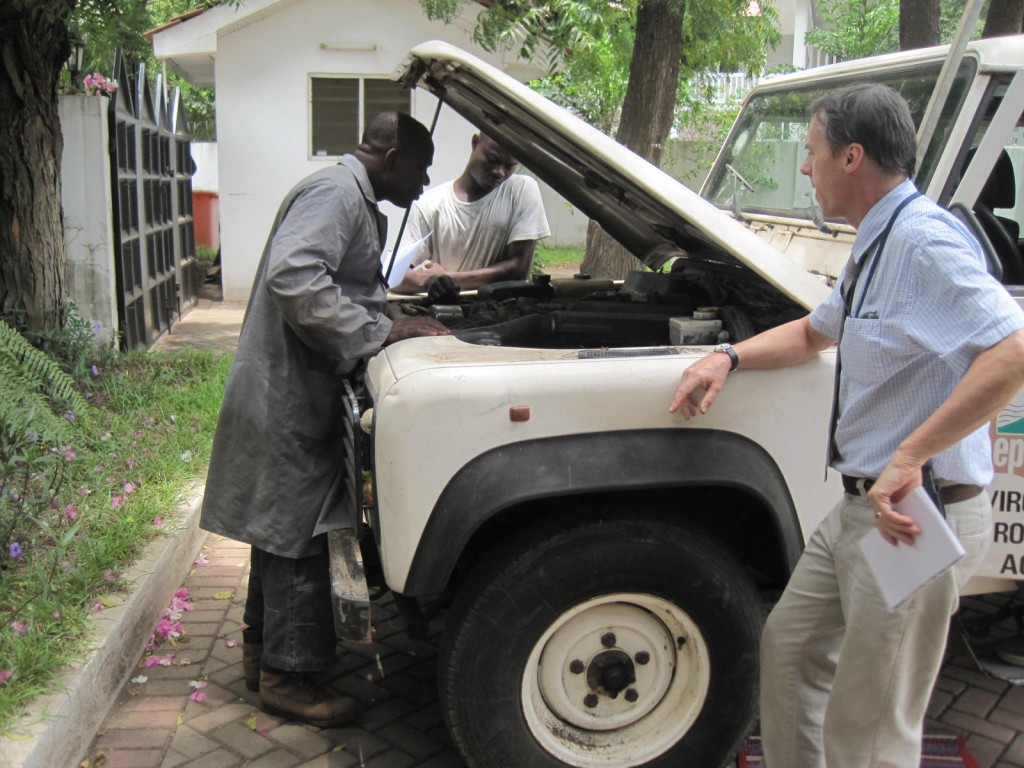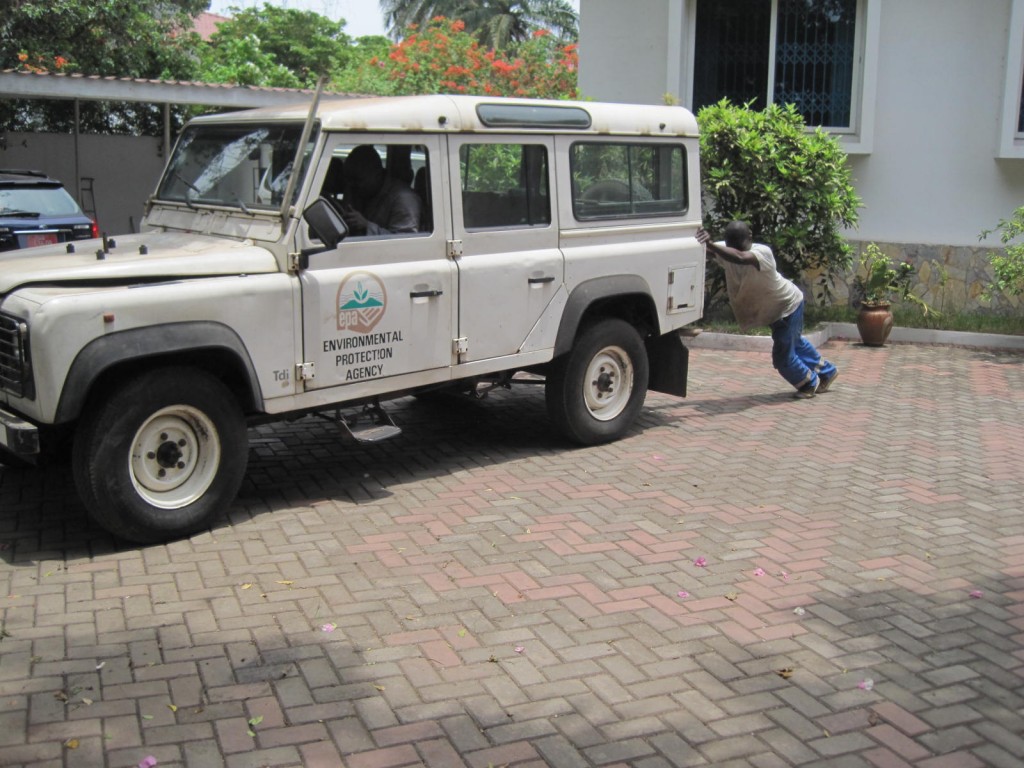Opere and one of his helpers came by shortly after I got the vehicle to look it over closely and after poking around the vehicle for a bit he comes up with a list of parts I need. Before I bought it Opere said it would take about GHC 4,000 to get it into good running order. Much of what is needed he knows without having to look at the vehicle, many of the items he just rattles off from experience that tells him what a 15 year-old Defender that has not been well taken care of is going to need. Brake and clutch parts and wheel bearings fall into this category.

Many of the parts are available locally but they are expensive here and Opere recommends I import them. One of the things I like about this approach is that my mechanic is not recommending something just to sell the parts, and can also tell me when something can be obtained locally. He does not seem to sell any parts This was a tip I initially received from Stephane, my Canadian High Commission colleague who was the original inspiration behind this project who was restoring a Defender when I first arrived in Ghana and is now back in Quebec with his Defender, he put me on to Famous Four, a parts depot based in the UK that specializes in Land Rovers and has a well-tuned mail order operation.
Using the Famous Four website www.famousfour.co.uk I am able to find everything on the list, and in the process familiarize myself with the range of parts that I might want. It is really a great site for Landy parts Some of them are genuine Land Rover parts but most are Original Equipment Manufacturer (OEM), from the regular supplier to Land Rover or “after market “ parts made by someone else as a copy of the original part. The prices are not bad, much less than I would pay here and they do not charge VAT on anything exported from the UK. The shipping costs are hefty but the per pound cost declines the heavier the order is, and the weight adds up when you start adding axles and drive shafts.
Opere and I have some interesting communication problems in the process of deriving the list of needed parts. We both speak English, but issues of accent, culture and jargon enter to pose some surprising challenges to my comprehension. Of course a big part of the problem is my less-than-complete mechanical knowledge. I never heard of a “servo” before, or a “slave cylinder”. If I don’t catch something the first time I don’t mind asking Opere to repeat it once or twice but after three times if I still am not sure of what part he is talking about I resort to pretending to understand and then writing down what I think I have heard and searching for it on parts sites on the internet. The best one was “axle”, which I had a hard time with in part because of his accent and in part because it not something I expected to hear that I would need. Apparently the “half-shaft” rear axles had been welded to the drive members, the pieces at the end of the axles that the wheels bolt onto. This left us both shaking our heads in disbelief.
Here is the list of original parts I am ordering from Famous Four. This will get the clutch and brakes and wheels and axles back into good running order. This is not the list Opere gave me, I have augmented it with items suggested by the helpful people at Famous Four, or by Ndoria, a Land Rover mechanic friend in Nairobi that is advising via email.
- Clutch Release Arm Fork
- Release Arm Slipper Pad
- Clutch Master Cylinder
- Clutch Slave Cylinder
- Clutch Kit, (Plate, cover, release bearing)
- Release Bearing Staple
- Push Rod Clip
- Clutch Flexi-Hose
- 2 Rear Half Shaft axles
- Stub Axle to Axle Case Gasket
- 2 Stub Axle Oil Seals
- 2 Drive Members
- 4 Wheel Bearing Kits
- Brake Master Cylinder
- 2 Rear Brake Caliper Seal Kits
- 2 Rear Brake Pad Set
- 2 Front Caliper Seal Kit
- Hose Bleed Assembly
- Front Brake Pad Set
- Bottom Water Hose
- By-pass Water Hose
- Top Water Hose
- Front Drive shaft
- 4 Hub Dust Caps
The front drive shaft we have to add because there simply isn’t one, perhaps someone found a better use for it. I add a few cosmetic things and items I do not need right away but that I want as part of the restoration or for general service and getting them now will bring the shipping cost down. Including shipping this first parts order will set me back $1200, which sets my total investment to date at $6,300 (including the battery) . At the end of it, with a couple of hundred dollars labour to put it together, I should have a vehicle with a good clutch, brakes and drive train, but which will still require some motor work and many, many other restorations and upgrades, including electrical, interior, and bodywork. I have now obtained a set of Land Rover repair manuals and a restoration book to serve as reference materials, these are proving very handy to my learning process.

Of course the big mechanical item is the motor. It runs but smokes quite badly, which might indicate worn pistons, a cracked block, dodgy injectors, or a blown head gasket. I knew before I bought the vehicle this was going to be a big part of the rebuild. For the motor Opere suggests I consider two options. I can have it rebuilt or I can import a “reconditioned” replacement TDI 300 from Europe and have Opere install it. Opere rebuilds Land Rover motors regularly in his shop under the tree (see separate post), but also brings in reconditioned motors from time to time, he calls them “new”, but they are only new to him. Again, this is a Ghanaian practice, the age of things is really measured from when it comes into the country, a used car might be 20 years old, but it is “new” when it lands at Tema Port. While the “new” motor is a bit more expensive than the rebuild, it is surprisingly affordable and much simpler than the rebuild, where I would have to import all the parts which could involve delays.
I am also nervous about what the rebuild might end up costing if we discover some unknown problem that is not easily fixable and adds significantly to the cost. I am also somewhat apprehensive about a rebuild given that the shop under the tree is not the ideal environment for working with sensitive moving parts. The reconditioned motor also comes with a number of parts that I need, like A/C and an alternator. One of the first decisions I make is to go for the reconditioned motor.
Opere says he has 3 TDI 300s coming in shortly and could install one while I am waiting for the other parts to be delivered. We negotiate quite hard on the price, as the objectivity present in my other dealings with Opere is lacking here (he is selling what he is installing) and I do not have another source. We settle on the Ghanaian equivalent of $2,000, with $1500 up front and $500 payable in one month upon satisfactory performance. Sort of a guaranteed guarantee. When it is done I will be up to $8,300 on my investment, including all the other parts I am ordering. That is still well within budget, but there is still a lot left to do.
